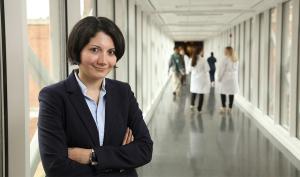
More than 60 million Americans live in rural communities, and according to the U.S. Centers for Disease Control and Prevention, they’re at greater risk of death from stroke, heart disease, cancer, emphysema and other chronic lower respiratory diseases, compared to people who live in urban areas.
Breakthroughs in robotics offer hope of delivering the best treatments and timely care to underserved communities. Across the United States, medical professionals are perfoming an increasing number of procedures aided by surgical robots, and it’s possible surgeries performed remotely could become more widespread in the future.
Homa Alemzadeh, assistant professor of electrical and computer engineering at the University of Virginia School of Engineering and Applied Science, has earned a prestigious National Science Foundation CAREER award to innovate cyber-physical systems for robotic surgery. The CAREER program, one of the NSF’s most prestigious awards for early-career faculty, recognizes the recipient’s potential for leadership in research and education.
Alemzadeh’s research will enable better training for surgeons by providing feedback within the specific context of their work with patients, with a goal of broadening the availability and increasing the safety of robotic procedures.
“The NSF CAREER award is critical to developing and testing a fully integrated cyber-physical solution for safety monitoring within virtual-reality and dry-lab simulation training settings,” Alemzadeh said. “We hope to eventually see our system transition to real practice and provide safety assurance in actual procedures, as a longer-term payoff of this grant.”
Cyber-physical systems, control and robotics are a combined research strength of UVA’s Charles L. Brown Department of Electrical and Computer Engineering and advance the mission of UVA Engineering’s Link Lab, where Alemzadeh is affiliated. She also holds a courtesy appointment in UVA Engineering’s Department of Computer Science.
“Human experts are the final decision-makers,” Alemzadeh said. “We seek to transfer their knowledge and expertise to the model and mechanisms we are designing, so that the system provides them with just-in-time and explainable feedback in response to every command.”
Medical cyber-physical systems involve hardware, software and mechanical parts working together with multiple humans in often-busy operating or treatment rooms. Robotic surgery physically extends a surgeon’s hands and eyes. Cyber-physical systems for robotic surgery provide improvements such as magnified 3D views, and the ability to perform tiny movements more accurately and filter out surgeons’ hand tremors.
Alemzadeh will use her $550,000 five-year CAREER Award to develop cyber-physical systems that function as a surgeon’s cognitive assistant, to detect and recover in real time from events that might harm the patient regardless of the cause – malicious cyberattacks, accidental electrical and mechanical malfunctions or software errors or unintentional human errors.
Alemzadeh will add hardware and software mechanisms to monitor what the surgeon and robot are doing in real time, and to anticipate and stop potentially unsafe actions before they become a risk. These mechanisms combine modeling of surgical workflows, machine learning, signal processing and decision processes to predict the most effective recovery actions for the surgeon and robot to take when alerted to a potential harm.
A surgical cognitive assistant should be able to closely analyze and replicate the surgeon’s workflows, including behavioral models and movements. The first step is to model a given task, like suturing, in a surgical procedure, using a set of standard granular movements, called motion primitives in robotics. The next step is to recognize the motion primitives within more complex procedures and verify their execution to categorize them as safe or potentially unsafe.
Alemzadeh’s research group members, Kay Hutchinson and Zongyu Li, Ph.D. students of electrical engineering, have spent the past year defining and analyzing these surgical motion primitives and using them for developing models for runtime gesture recognition and error detection in robot-assisted surgery. Preliminary analyses are reported in Analysis of Executional and Procedural Errors in Dry-Lab Robotic Surgery Experiments, published February 2022 in the International Journal of Robotics and Computer Assisted Surgery and in Runtime Detection of Executional Errors in Robot-Assisted Surgery, recently presented at the IEEE International Conference on Robotics and Automation.
Members of Alemzadeh’s research group collaborate closely with Dr. Noah Schenkman, John Kluge Professor of Urology in the UVA School of Medicine, who performs robotic surgeries for UVA Health’s urology department, and gynecological oncologist Dr. Leigh Cantrell, associate professor in UVA Health’s Division of Gynecologic Oncology and obstetrics and gynecology residency program director.
UVA is one of the few universities in which top schools of Engineering and Medicine are within a one-mile radius of each other. This proximity accelerates the creation of knowledge at the intersection of engineering and medicine and explains why engineering for health is a top research area for UVA Engineering.
A seed grant from the University of Virginia’s Center for Engineering in Medicine supported Alemzadeh’s early work to prove her concept on a simulator, allowing her to make progress and submit preliminary results with her NSF grant proposal even though the COVID-19 pandemic temporarily halted hospital-based research.
The principles and techniques are applicable to other types of robots and devices that augment human decision-making in complex and stressful situations such as medical triage and disaster response, Alemzadeh said.